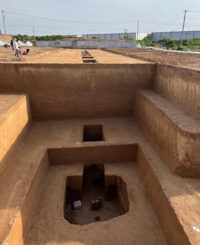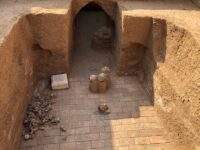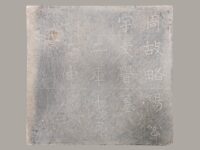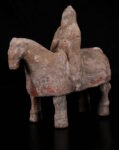 Archaeologists have unearthed the tomb of Yuwen Jue, Emperor Xiaomin of Northern Zhou, founder of the Northern Zhou Dynasty (557-581 A.D.) in Xianyang, northwest China. This is only the second tomb of a Northern Zhou emperor to be excavated.
Archaeologists have unearthed the tomb of Yuwen Jue, Emperor Xiaomin of Northern Zhou, founder of the Northern Zhou Dynasty (557-581 A.D.) in Xianyang, northwest China. This is only the second tomb of a Northern Zhou emperor to be excavated.
The tomb was found in Hongdu Plain area of Xianyang City, a site where several tombs of elites from the Northern (439-581 A.D.), Sui, and Tang (581-907 A.D.) dynasties have been unearthed. The tomb of Yuwen Jian, Yuwen Jue’s younger brother and the eighth son of Yuwen Tai, Emperor Wen of Western Wei, was found a half-mile to the east. The only other Northern Zhou imperial tomb excavated, the tomb of another of Xiaomin’s younger brothers, Yuwen Yong, Emperor Wu, is five miles to the east.
 The tomb was originally enclosed by a rectangle of ditches 482 feet long and 344 feet wide. The emperor’s tomb is a single-chamber earthen cave tomb with four patios in the north-central position of the rectangle bounded by the ditches. The floor of the tomb is 30 feet from the surface, which makes it medium-sized for tombs from the Northern Zhou era.
The tomb was originally enclosed by a rectangle of ditches 482 feet long and 344 feet wide. The emperor’s tomb is a single-chamber earthen cave tomb with four patios in the north-central position of the rectangle bounded by the ditches. The floor of the tomb is 30 feet from the surface, which makes it medium-sized for tombs from the Northern Zhou era.
 The tomb was pillaged in antiquity and its contents disturbed, but the thieves left plenty behind. The team unearthed 146 artifacts, most of them in the southeast section of the tomb and most of them terracotta figures of people (warriors, mounted cavalry, women), animals and legendary creatures. On the east side of the entrance, archaeologists found the stone inscribed with the emperor’s epitaph, the characters painted red with cinnabar. It translates to “Renshen in October of the second year of the tomb of Gongyu Wenjue, Duke of Lueyang, Zhou Dynasty.”
The tomb was pillaged in antiquity and its contents disturbed, but the thieves left plenty behind. The team unearthed 146 artifacts, most of them in the southeast section of the tomb and most of them terracotta figures of people (warriors, mounted cavalry, women), animals and legendary creatures. On the east side of the entrance, archaeologists found the stone inscribed with the emperor’s epitaph, the characters painted red with cinnabar. It translates to “Renshen in October of the second year of the tomb of Gongyu Wenjue, Duke of Lueyang, Zhou Dynasty.”
 He held the title of Duke at the time of his death in 557 A.D., even though he was the ruler of the new dynasty he had just founded months earlier. It was his brother Emperor Wu who declared him emperor posthumously after his own ascension to the throne in 572 A.D.
He held the title of Duke at the time of his death in 557 A.D., even though he was the ruler of the new dynasty he had just founded months earlier. It was his brother Emperor Wu who declared him emperor posthumously after his own ascension to the throne in 572 A.D.
According to archaeologists, the archaeological discovery of the tomb of Yuwen Jue in Northern Zhou is of great significance. First of all, the discovery can further clarify that the tombs of the Northern Zhou emperors have the same ground structure as the high-level tombs of the Northern
Zhou. Secondly, Yuwen Jue was buried as the “Duke of Lueyang”, providing physical evidence for the political struggle during the founding period of the Northern Zhou Dynasty and supplementing the historical materials of the Northern Dynasty. Finally, the determination of the location of the Jingling Tomb provides important indication information for the distribution of the remaining three imperial tombs in the Northern Zhou Dynasty.